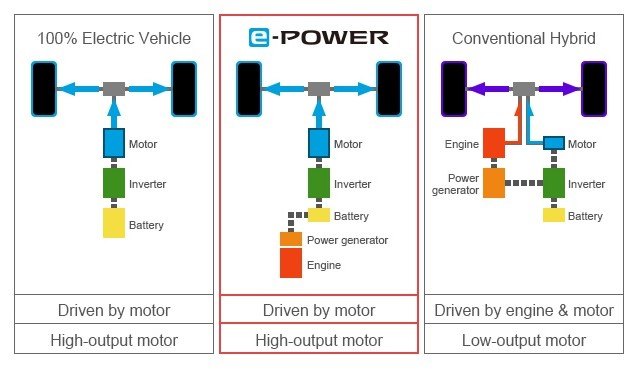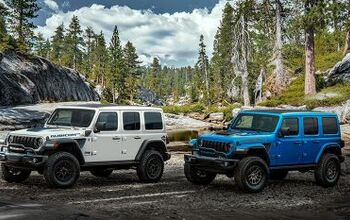Before E-Power Makes It Here, Nissan First Has to Send It to the Gym

Whether the buying public likes it or not, there’s a tsunami of electrified powertrains headed for U.S. shores. Automakers the world over hope to beat their rivals in the race to a “fully electrified” lineup, which just means there’ll be — at a minimum — a hybrid variant in each model line.
It’s far less sexy than headlines make it sound. Still, if you’re into technology and saving money at the pumps (not necessarily at the dealer), it’s hot stuff. Nissan’s taking an unconventional route in this race, forgoing a conventional hybrid setup for an inexpensive stopgap solution all its own.
The system, called e-Power, is already a hit in Japan. But before it makes its way into high-end Nissan products (read: Infiniti), it first needs to upsize the system for American-sized vehicles travelling at American-sized speeds. That’s not as easy as it sounds.
e-Power combine an electric motor and a conventional gasoline engine, but, unlike a normal hybrid, the two powerplants do not take turns handling propulsion duties. The continuously running ICE (operating at a fixed rpm) continuously feeds a small battery via a generator, which in turns powers the electric motor that drives the wheels. Propulsion always comes from the electric motor, but the battery’s juice always comes from an ICE. (A small amount of energy is recaptured via regenerative braking.)
Launched in Japan in late 2016, the little Nissan Note e-Power hatchback utilizes a 1.2-liter four-cylinder running at a constant 2,500 rpm for its electricity generation. The automaker claims 70 percent of Note buyers in that market choose e-Power, making the vehicle line quite a profitable one. Nissan has since added e-Power to a midsize minivan.
Unfortunately, flitting around the crowded urban streets of Japan is a very different situation than intercity travel in Europe or the United States. For the vehicle to be ultra efficient, the engine needs to operate at an optimum speed. However, sustained high-speed cruising would deplete the battery faster than the engine/generator could replenish it.
This is what Nissan’s trying to figure out as it contemplates launching e-Power in Europe — and whatever lessons learned on the continent will surely be applied to the U.S., where Nissan promises e-Power availability in the near future. Its Infiniti division plans to go “electrified” by 2021, and it’s much easier to hide additional powertrain costs in a pricier vehicle’s sticker.
Ponz Pandikuthira, Nissan’s vice-president of product planning, told Automotive News Europe that “Japanese driving rewards e-Power,” but the equation falls apart outside the city. Still, the system’s efficiency still tops that of diesel propulsion by 10 to 15 percent, he said. Because of the system’s benefits, it seems Nissan plans to do whatever’s necessary to adapt it to Western roads.
“EPower is far less expensive to execute than a plug-in hybrid because you don’t have the extra costs and 400 kg of the battery weight,” Pandikuthira said, calling e-Power “a great bridge technology.”
Testing is ongoing at Nissan’s UK R&D facility with a Nissan Altima outfitted with a 2.4-liter engine/generator, he added.

More by Steph Willems
Latest Car Reviews
Read moreLatest Product Reviews
Read moreRecent Comments
- Master Baiter Toyota and Honda have sufficient brand equity and manufacturing expertise that they could switch to producing EVs if and when they determine it's necessary based on market realities. If you know how to build cars, then designing one around an EV drive train is trivial for a company the size of Toyota or Honda. By waiting it out, these companies can take advantage of supply chains being developed around batteries and electric motors, while avoiding short term losses like Ford is experiencing. Regarding hybrids, personally I don't do enough city driving to warrant the expense and complexity of a system essentially designed to recover braking energy.
- Urlik You missed the point. The Feds haven’t changed child labor laws so it is still illegal under Federal law. No state has changed their law so that it goes against a Federal child labor hazardous order like working in a slaughter house either.
- Plaincraig 1975 Mercury Cougar with the 460 four barrel. My dad bought it new and removed all the pollution control stuff and did a lot of upgrades to the engine (450hp). I got to use it from 1986 to 1991 when I got my Eclipse GSX. The payments and insurance for a 3000GT were going to be too much. No tickets no accidents so far in my many years and miles.My sister learned on a 76 LTD with the 350 two barrel then a Ford Escort but she has tickets (speeding but she has contacts so they get dismissed or fine and no points) and accidents (none her fault)
- Namesakeone If I were the parent of a teenage daughter, I would want her in an H1 Hummer. It would be big enough to protect her in a crash, too big for her to afford the fuel (and thus keep her home), big enough to intimidate her in a parallel-parking situation (and thus keep her home), and the transmission tunnel would prevent backseat sex.If I were the parent of a teenage son, I would want him to have, for his first wheeled transportation...a ride-on lawnmower. For obvious reasons.
- ToolGuy If I were a teen under the tutelage of one of the B&B, I think it would make perfect sense to jump straight into one of those "forever cars"... see then I could drive it forever and not have to worry about ever replacing it. This plan seems flawless, doesn't it?



































Comments
Join the conversation
AHA ! Thank you, Best & Brightest !
This is what a BMW i3 turns into when the biggish battery runs down and the Mighty Powerhouse 700cc two cylinder "range extender" allows you to mope along to a charging station. There's zero to see here technically. Nothing at all. It's a Mark 1 series hybrid system chosen by no one else for an obvious reason. It only works properly in city traffic. On the highway, a gas engine encumbered by driving a generator as well as a battery driving an electric motor both involve energy conversion losses that a straight gear drive avoids. In town you can juggle things about for a gain. GM's mild hybrid from 2008 on, and the new German 48V hybrid system, also picked up by Chrysler for the new V6 RAM, are somewhere between Mark 0 and Mark 1. All pimples on the path of progress, but no doubt soon to be deified by overenthusiastic PR donkeys trained to bray appropriately as if the world had been transmogrified for the better in a startling way. What they really do is provide a darn good fast start in a stop/start system, or drive an engine for a few seconds to cover up low rpm main turbo lag, still not really covered up by all these new designs.